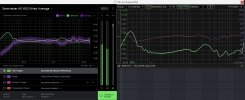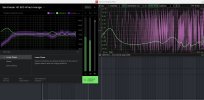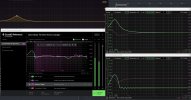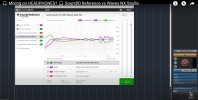We use EQ at OS level (Equalizer APO on Windows, Pulse Equalizer on Linux or eqMac on MacOS for example) or audio interface level (RME ADI PRO) to correct headphone tonality. You imply this is bad and claim you can hear artifacts with headphone EQ. What are the settings and what content do I have to check to hear these artifacts?Do you use reverb first and then EQ and compression, or the other way around?
Or do you use it as a send effect?
-
Welcome to ASR. There are many reviews of audio hardware and expert members to help answer your questions. Click here to have your audio equipment measured for free!
You are using an out of date browser. It may not display this or other websites correctly.
You should upgrade or use an alternative browser.
You should upgrade or use an alternative browser.
Headphone EQ Artifacts: Phase Shifts, Pre-Ringing, and Their Impact on Headphone Reviews?
- Thread starter BZ22
- Start date
Headphones like other transducers are minimum-phase by nature. This means that any frequency response deficiency corrected by EQ will also correct transient and phase response. If you hear detrimental effects from EQ revise your settings and make sure the EQ used is an IIR, minimum-phase type.I do not use EQ for my headphones or studio monitors while producing or mixing because I know it affects the transients and the phase.
ZolaIII
Master Contributor
- Joined
- Jul 28, 2019
- Messages
- 5,210
- Likes
- 3,066
A response (purple), beem of it ± (light purple) and negative of response towards target. It's a minimum phase FIR implementation. Other picture is the same but linear phase and ilustrate how it continues to beem as crazy after it's applied. In order to understand it you need to start from time domain basics which is impulse response, harmonics to fundamental... Afterwards that Ideal doesn't exist how over dumped is unnatural and that our brain knows very good to complete for it if it's static or trained like familiar room you spend a lot of time in.Can someone explain to me what these wobbly curves in the calibration curve in SoundID Reference in Zero Latency Mode are supposed to represent?
BZ22
Member
- Joined
- Jul 25, 2024
- Messages
- 42
- Likes
- 15
- Thread Starter
- #25
Thank you. I find it very interesting how different EQs can operate and vary from each other.
So many complex factors can come into play, although I don't 100% agree with your statement that people perceive frequencies differently.
I believe that when two different engineers, both without hearing loss, listen to the same reference track, they might highlight or 'ignore' different aspects, but this is mostly true for the first time they listen to the reference track.
Then, of course, experience also plays a role in being able to better assign things like compression or reverb spaces.
So many complex factors can come into play, although I don't 100% agree with your statement that people perceive frequencies differently.
I believe that when two different engineers, both without hearing loss, listen to the same reference track, they might highlight or 'ignore' different aspects, but this is mostly true for the first time they listen to the reference track.
Then, of course, experience also plays a role in being able to better assign things like compression or reverb spaces.
BZ22
Member
- Joined
- Jul 25, 2024
- Messages
- 42
- Likes
- 15
- Thread Starter
- #26
I already answered that.Before you call users in this forum "a problem", please answer the question if you were using minimum phase or linear phase filters to EQ headphones when you heard the EQ artifacts?
I have FL Studio, teach me.
And I wonder why you think I labeled and referred to users from this forum as a problem with 'Headphone Reviewer.'
I actually meant the YouTube candidates, If you want to know exactly.
Looks like a bug in the software causing it to choose a suboptimal time window. Try reporting the problem to Sonarworks and see what they say.Can someone explain to me what these wobbly curves in the calibration curve in SoundID Reference in Zero Latency Mode are supposed to represent
BZ22
Member
- Joined
- Jul 25, 2024
- Messages
- 42
- Likes
- 15
- Thread Starter
- #28
What? Do you really want to claim that the world’s best EQ correction software, used by professional sound engineers/producers (with overly bright mixes), has a bug?Looks like a bug in the software causing it to choose a suboptimal time window. Try reporting the problem to Sonarworks and see what they say.
I'm almost sure that it’s unfortunately not a bug
Edit: It's not
Attachments
Last edited:
BZ22
Member
- Joined
- Jul 25, 2024
- Messages
- 42
- Likes
- 15
- Thread Starter
- #29
I mentioned it in the previous thread but not in this one, that I use the RME TotalMix 3-band EQ to add more low-end to my Edition XS.
It sounds fantastic, fast and without distortion.
 ? I was only referring to software EQs like APO or SoundID Reference.
? I was only referring to software EQs like APO or SoundID Reference.
I would also love to try an RME ADI-2 or something similar, but I need to look into how I can solve this since I already have a RME Babyface Pro FS, which I want to continue using.
I think this is the best way to use EQ for headphones.
Nothing compares to RME, whether it's neutrality, distortion performance, or latency.
It sounds fantastic, fast and without distortion.
Why do you always assume things I never mentionedor audio interface level (RME ADI PRO) to correct headphone tonality. You imply this is bad and claim you can hear artifacts with headphone EQ. What are the settings and what content do I have to check to hear these artifacts?
I would also love to try an RME ADI-2 or something similar, but I need to look into how I can solve this since I already have a RME Babyface Pro FS, which I want to continue using.
I think this is the best way to use EQ for headphones.
Nothing compares to RME, whether it's neutrality, distortion performance, or latency.
Last edited:
ZolaIII
Master Contributor
- Joined
- Jul 28, 2019
- Messages
- 5,210
- Likes
- 3,066
My favourite story to tell how much mixing - mastering engineer really worth. Watch the complete video! Originally it who's mixed on "horrible" NS10M's (which aren't really terrible but you need to know to use them) mostly.Thank you. I find it very interesting how different EQs can operate and vary from each other.
So many complex factors can come into play, although I don't 100% agree with your statement that people perceive frequencies differently.
I believe that when two different engineers, both without hearing loss, listen to the same reference track, they might highlight or 'ignore' different aspects, but this is mostly true for the first time they listen to the reference track.
Then, of course, experience also plays a role in being able to better assign things like compression or reverb spaces.
Sonarwork's SoundID is in the forever beta (last 5 years or so) on platforms that I know of and full of bugs and not so good measurements. Use Auto-EQ instead and again same HATS and ear model for measurement's and target.
A lot of work still ahead of us regarding making average of different ear models and inner ear channel models and it will still be only average. For now you have JM1 attempt regarding that.
KSTR
Major Contributor
Well, corrective EQ (and headroom management) is always last in the chain, in my case right in the monitoring DAC/HP-Amp (RME ADI-2 Pro). Room EQ for speakers is done in a convolver plugin, again last in the chain and outside the signal path a such.With SoundID in Zero Latency Mode using my HD 600
Do you use reverb first and then EQ and compression, or the other way around?
Or do you use it as a send effect?
We want to EQ the headphone or room/speakers, not the signal.
Technically, as long as processing is a) linear and b) done in floating point math, order in a sequence of effects does not matter, though. Therefore, any non-linear processing like compression/saturation, exciters etc must take place before the corrective EQ.
I think it certainly does. See above. And what would be the alternative anyway?I think that room EQs on the master bus or in the system do not provide an optimal solution for neutrality in sound engineering.
Please double-check your impressions with a linear-phase EQ with the same magnitude response. Most likely you will find that it spoils the sound, especially transients, much more than minimum phase EQ.I also have the impression that minimum-phase EQs alter the phase of the signal in such a way that, for example, impulse responses from reverb units, which are very sensitive to phase shifts, become less precise or clear.
These are characteristics that I believe are often overlooked.
Minphase EQ does alter the signal, by definition, and thus gives slightly different perception of transients, as a direct implication of the changed frequency response (magnitude and phase).
But it does that in the most natural way and with no artifacts whatsoever. That's a fundamental of basic signal/systems theory and practice, nothing to debate here IMO.
BZ22
Member
- Joined
- Jul 25, 2024
- Messages
- 42
- Likes
- 15
- Thread Starter
- #32
Oh my god, the Eventide Harmonizer he mentioned at 11:35... I think it's the Eventide H3000?
Every time I use this plugin on synths, especially on DX7, it sounds so good that I just melt from my chair to the floor.
But it has this "problem" where some preset settings require a bit of negative track delay to be perfectly on point.
I don't like the modern alternative that all sound engineers use, the Soundtoys Microshift, as much as the H3000 on Synths.
But on guitars, Microshift sounds a bit better (more modern sound).
Sorry for going off-topic, but I had to
I think it's completely okay that our opinions differ a bit here, and I have actually already expressed all my thoughts on the matter and which solutions might be better suited.I think it certainly does. See above. And what would be the alternative anyway?
I also notice that you don't react offended or anything to my statements, and I really appreciate that!
As I mentioned before, for example, I don't like my HD 600 with EQ at all.
I want it exactly as it was originally tuned with its strengths and characteristics.
I believe we shouldn't open the topic of speakers/studio monitors because then the good ol physics would come into play and we would end up with headaches, which we already have anyway because we've chosen this path
Last edited:
KSTR
Major Contributor
BZ22
Member
- Joined
- Jul 25, 2024
- Messages
- 42
- Likes
- 15
- Thread Starter
- #34
Yes, I agree. On a quest, at sea with the santa mariaI would think in the end these are "whatever floats your boat" scenarios.
I would also like to listen to the HD 700 and HD 800 S myself.I personally do enjoy my HD700 un-EQ'd as well. It sounds different but still enjoyable, though a lot of material is rendered more balanced with a bit of gentle corrective EQ.
I got the Arya Stealth yesterday, which instantly replaced my XS.
Less than 3dB boost under 100Hz, everything I need
Similar threads
- Replies
- 47
- Views
- 4K
- Replies
- 0
- Views
- 116
- Replies
- 23
- Views
- 2K
- Replies
- 21
- Views
- 2K
- Poll
- Replies
- 18
- Views
- 2K



